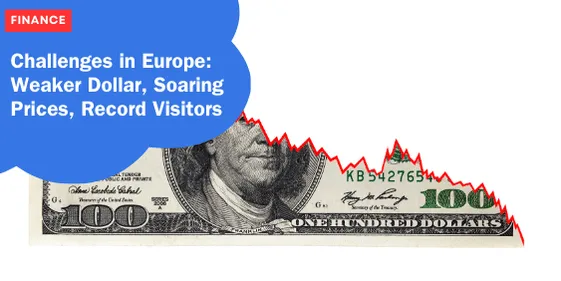Challenges in Europe: Weaker Dollar, Soaring Prices, Record Visitors

As temperatures soar across Europe, travelers are facing a summer of unprecedented challenges.
From fluctuating currencies to skyrocketing prices and record-breaking visitor numbers, navigating the continent has become more daunting than ever.
Currency Woes: Impact of a Weak Dollar
One of the primary concerns for American travelers is the weakening of the dollar against major European currencies.
As of recent reports, the dollar’s value has declined significantly compared to previous years.
For instance, against the euro, the dollar now exchanges at approximately 91 or 92 cents, down from higher values seen just a year ago.
This decline translates to increased expenses for travelers purchasing goods and services in Europe.
Similar trends are observed in the UK, where the dollar’s exchange rate has also fallen, making travel expenses higher than in recent periods.
While there are exceptions—such as the dollar strengthening against certain currencies like the Czech koruna and the Hungarian forint—overall, travelers face a less favorable exchange rate across much of Europe.
Soaring Prices: Impact on Travel Costs
Accompanying the currency challenges are steep price hikes in various sectors, notably in accommodation and tourist attractions.
Hotels in major cities have seen prices surge dramatically, driven by high demand and limited availability.
For example, what was once a $300 per night room may now cost upwards of $500 during peak periods, reflecting the scarcity of available accommodations.
Moreover, popular tourist sites have also raised their entry fees.
Iconic landmarks like the Eiffel Tower and Istanbul’s Hagia Sophia have implemented significant price increases to manage overcrowding and maintain upkeep.
Record Visitor Numbers: Coping with Crowds
Despite these financial hurdles, Europe is experiencing a surge in tourist arrivals, particularly from the United States.
Industry experts report that 2023 surpassed pre-pandemic levels in terms of American visitors, and 2024 is on track to exceed those figures.
This influx has created challenges not only in managing crowds but also in preserving the quality of the tourist experience.
To mitigate the impact of overcrowding, travelers are advised to explore alternative destinations or visit popular cities during less busy periods.
For instance, opting for regional France over Paris or choosing lesser-known towns along the Amalfi Coast can offer a more relaxed and affordable experience.
Airfare Trends: Fluctuations and Opportunities
Amidst the financial pressures, there’s a silver lining in airfare trends.
Flight prices between the US and Europe have shown a downward trend compared to recent years, making travel more accessible for those able to secure flights in advance.
According to travel data, average round-trip fares have decreased by 16% from 2023 levels, presenting opportunities for budget-conscious travelers.
Planning Tips: Securing a European Summer
For travelers still contemplating a European adventure this summer, early planning is essential.
Booking flights and accommodations well in advance can help secure better rates and availability, especially for peak season travel.
Alternatively, consider traveling during shoulder seasons like September, when fares tend to drop and crowds thin out.
However, flexibility remains key.
Exploring alternative accommodations, adjusting travel dates, or opting for less touristy destinations can all contribute to a more affordable and enjoyable European experience amidst the current challenges.
In conclusion, while navigating Europe this summer presents its share of obstacles—from financial considerations to logistical planning strategic choices and early preparations can still ensure a memorable and rewarding journey across the continent.






